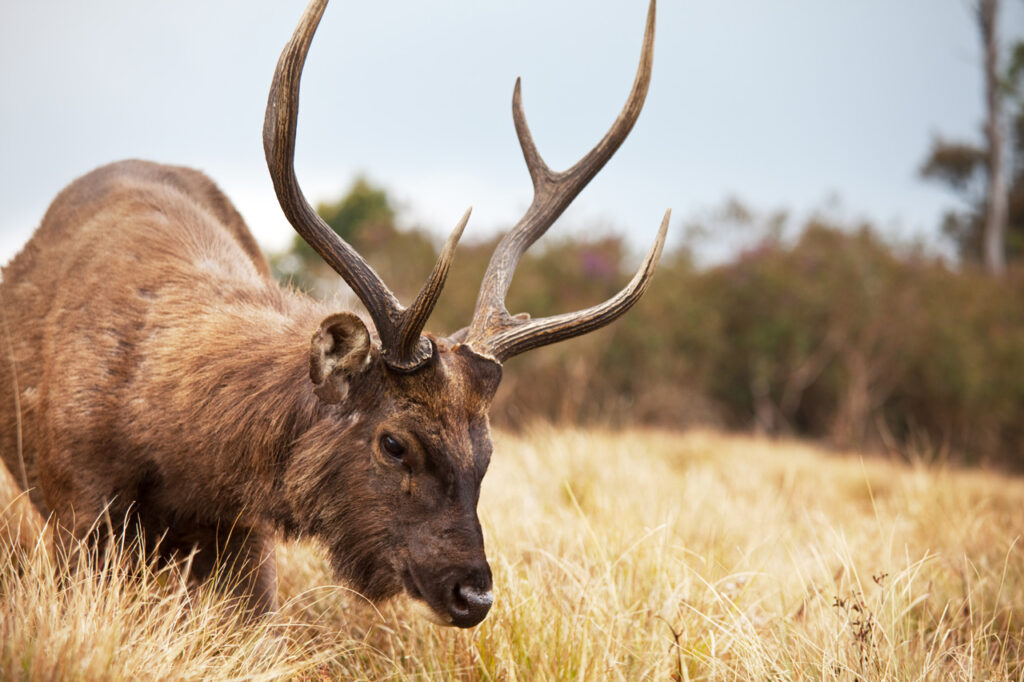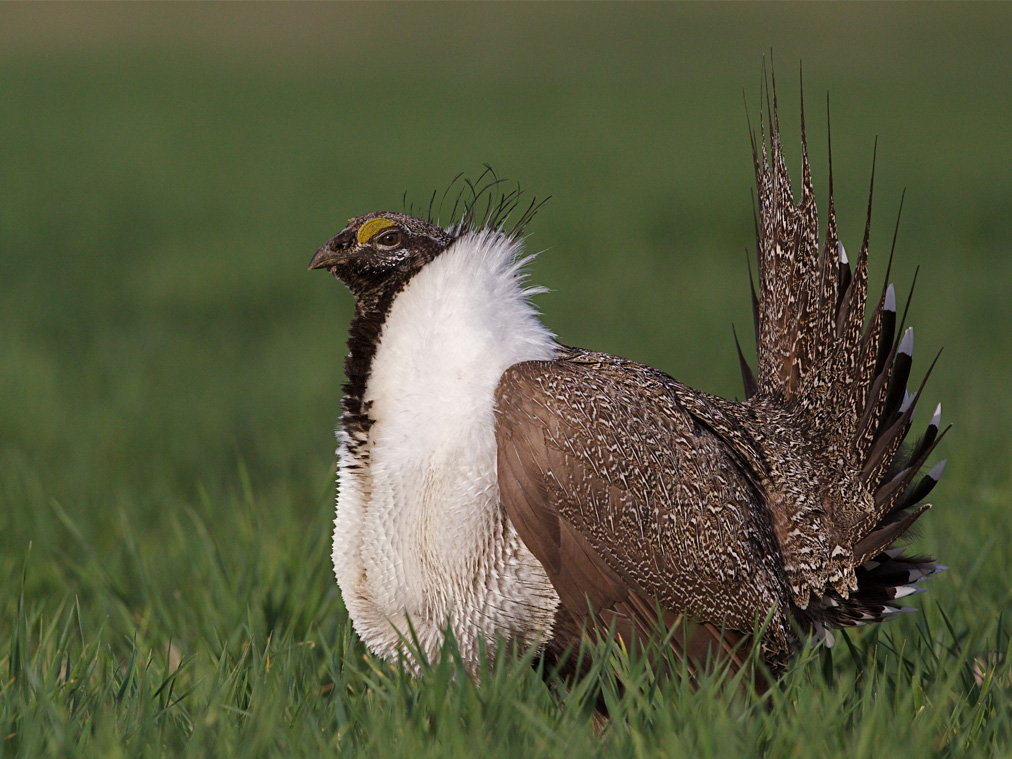Our Approach to Land
We apply strict environmental standards across the mining process — from exploration and development to active mining and reclamation. Before beginning the mine permitting process, we assess potential environmental impacts — through careful analysis — and implement mitigation plans to reduce such impacts.
As part of this effort, we routinely analyze baseline hydrology (including water quality and quantity), existing biological communities, the presence of endangered species, cultural resources, landscape structure and soil conditions, and native plant species, among other aspects.
Our industry is one of the most highly regulated business sectors in the United States. We operate under an extensive regulatory regime that includes state and federal components of the Surface Mining Control and Reclamation Act, Clean Water Act, Clean Air Act, Safe Drinking Water Act, Resource Conservation and Recovery Act, Emergency Planning and Community Right to Know Act, Toxic Substances and Control Act, and National Environmental Policy Act, among others. Our team of skilled and experienced environmental engineers and compliance managers work closely with state and federal agencies to promote the compliance of our operations with applicable laws and regulations.
Our operations have restored more than 40,000 acres of former mine lands since 2016
Reclamation
As a routine and required stage of the overall mining lifecycle, Arch devotes significant
time and attention to reclaiming sites after mining activities are completed. Our subsidiaries undertake contemporaneous reclamation at all active sites. In addition to timely and contemporaneous reclamation of active sites, we take steps to responsibly manage idled and closed mine assets, including pre-existing obligations associated with prior acquisitions. Included in this latter category are transferred properties where we apply our expertise and a range of innovative practices to mitigate and eliminate water impacts and shorten the amount of time needed for ongoing treatment.
In every operating region, we take our reclamation efforts seriously and are often recognized for excellence by state and federal agencies. Each reclamation project is viewed as unique, and great attention is paid to enable the land to be restored to its approximate original contours and to an equal or better post-mining land use. Often the reclaimed land is indistinguishable from surrounding terrain within just a few growing seasons. We are committed to pursuing continuous improvement in our reclamation so that we leave sustainable lands for both wildlife and community needs.
We take pride in our restoration efforts — whether for wildlife habitat, range land, forestland or community use — and we work diligently to enable the land to be returned to equal or better condition than that which prevailed in its pre-mining state.
Arch subsidiary operations have claimed one of the top two national honors for reclamation excellence and community engagement — the National Reclamation Award and the Good Neighbor Award — three times in the past five years.
In 2023, the Thunder Basin Coal Company was awarded the Office of Surface Mining Good Neighbor Award, which honors that operator that engages with the community and surrounding landowners in the most exemplary fashion during a highly effective reclamation process.
Leer South claimed the Greenlands Award, the State of West Virginia’s highest honor for environmental achievement, during 2023. In addition, the West Elk mine was honored by the State of Colorado with the Excellence in Mining Reclamation Award.
The West Elk mine in Colorado was honored in 2023 for Excellence in Reclamation by the Colorado Division of Reclamation Mining and Safety for its efforts to re-use materials to avoid land disposal.
In recognition of its efforts, Arch has received state reclamation awards in West Virginia and Maryland in eight of the past 12 years and has received the coveted Appalachian Regional Reforestation Initiative (ARRI) Award three times in the past decade.

Arch’s reclaimed mine lands in the western United States are more productive than the native terrain, provide better grazing for livestock, and support a rich array of wildlife.
The ARRI initiative is a cooperative effort between the U.S. Department of the Interior’s Office of Surface Mining Reclamation and Enforcement (OSMRE); the states of Kentucky, Maryland, Ohio, Pennsylvania, Tennessee, Virginia, and West Virginia; environmental organizations; academia; industry partners; local, state and federal government agencies; and private landowners. Each year, a single award is presented to the reforestation reclamation project that best achieves the ARRI objectives of 1) re-establishing high-value hardwood trees on reclaimed mine lands in Appalachia, 2) increasing the survival rates and growth rates of planted trees, and 3) expediting the establishment of forest habitat through natural succession.
In 2022, the Coal Creek Mine was awarded the Excellence in Mining Reclamation Award from the Wyoming Department of Environmental Quality. This award recognized Arch’s commitment to leaving the land in a natural, beneficial and highly productive state once mining is completed. In early 2023, the Black Thunder mine received this same honor for obtaining bond release across reclaimed areas.
In early 2023, Arch received three reclamation awards from the state of West Virginia for exemplary construction techniques on a haul road, exemplary reclamation techniques on a refuse impoundment, and exemplary reclamation techniques on a surface mine.
During 2023, Arch’s Powder River Basin subsidiary achieved final reclamation and release on more than 800 acres of grassland habitat, which is a critical component of a healthy ecosystem.
In Wyoming, our subsidiary operations utilize practices that enable reclaimed habitat to provide needed forage, nesting and coverage requirements for native bird species. Reclamation grading and landscaping simulate the topography of the native lands, and specific seed mixtures of native grasses and shrubs are selected to replicate pre-mine habitat.
Overall, our operations have restored more than 40,000 acres of reclaimed land since 2016. In recent years, we have placed particular emphasis on completing Phase III release, which is the final stage of bond release on reclaimed areas, as well as the final regulated step in the mining process. State regulatory inspectors oversee and approve each successive step in the process and ultimately approve final release of the properties from protective reclamation bonds. We have placed a major emphasis on reclamation and bond release companywide. Final release is only granted once an operation has demonstrated that the landscape has been successfully reclaimed and that the vegetation is effectively established and stable.
Ecosystem Management
Arch and its subsidiaries understand and embrace the importance of protecting, restoring and enhancing ecosystems in our operating regions before, during and after mining takes place, and our subsidiaries work to protect, restore, and enhance ecosystems at all of their operating sites. With help from a variety of organizations, we go to great lengths to protect, preserve, and establish suitable habitats for wildlife. Our properties often serve as wildlife reserves for a variety of native species, even while reclamation is still under way.



Arch is engaged in efforts to conserve and expand the Burrowing Owl, Wild Elk and Greater Sage Grouse populations and habitat, among other species.
In particular, our subsidiaries have made substantial efforts to protect and promote avian populations, with a particular emphasis on raptor species. Our Wyoming subsidiary has worked to provide improved habitat on reclaimed lands, establishing new and replacement nesting structures, and relocating and rescuing birds as needed. The Wyoming operations have also initiated an Avian Protection Plan (APP) with the goal of eliminating or minimizing risks to avian species protected under the Migratory Bird Treaty Act (MBTA), including risks posed by above-ground power lines and associated electrical structures. As part of the initial work for the plan, all electrical structures on our sites were scrutinized by wildlife professionals to evaluate potential impacts. We have since removed 100 percent of the identified hazards. This work included removing power lines and poles and providing alternate perches for such species as the Golden Eagle. Additionally, our operations have built nesting platforms on reclaimed land to encourage nesting away from active operations, and have created nest sites using natural substrate including trees, rock, outcrops and banks.
In an ongoing raptor study, our Wyoming operations are working with and supporting the U.S. Fish and Wildlife Service (USFWS) to study the nesting and migration patterns of the Burrowing Owl, a regional species that thrives on and around our Wyoming operations.
Furthermore, our Wyoming subsidiary has worked for more than five years with state and local conservation groups in an effort to protect the Greater Sage Grouse. The Greater Sage Grouse, which is found in sagebrush country in the western United States, is the largest grouse in North America. The bird’s numbers began declining in the second half of the 20th century in many areas, resulting in the USFWS proposing the Greater Sage Grouse as a candidate for protection under the Endangered Species Act. Arch’s Wyoming subsidiary is a member of the Thunder Basin Grassland Prairie Ecosystem Association. This association, which won a U.S. Department of Interior Good Neighbor Award for its efforts, was created to develop core protection areas and to provide stipulations for development within these areas as part of an effort to conserve and expand the species through habitat enhancement. Candidate conservation agreements for the sage grouse were developed and approved by the USFWS, and act to protect and enhance habitat critical to the bird’s ongoing success.
Arch Resources has fully reclaimed and released nearly 16,000 acres in southern Wyoming. These acres have been restored to a level that exceeds pre-mining conditions, and support rich wildlife and livestock grazing populations. This reclamation effort, completed in strict accordance with permits issued by the State of Wyoming under the federal SMCRA regulations, completes the lifecycle of mining on these acres. This constitutes the final approved reclamation of over 98 percent of the area of mining disturbance. The remaining 2 percent footprint has yet to complete its 10-year waiting period and is scheduled to do so in the near term.
Arch is in the third year of a three-year pledge to provide the University of Wyoming’s School of Energy Resources with an aggregate $500,000 in support of students, researchers and faculty who are dedicated to the development of technology and methods for restoring former mine land to a condition that facilitates its highest and best future use, and/or for using coal in an increasingly clean and climate-compatible manner.
As a further example of our commitment to wildlife and habitat enhancement and utilization, our land management subsidiary has teamed with the Rocky Mountain Elk Foundation (RMEF) on a conservation easement in northeastern Wyoming covering some 1,000 acres of reclaimed mine property. This land, which lies in the heart of the Thunder Basin National Grassland ecosystem, has helped support a thriving elk population for the past 15 years or so. RMEF’s annual surveys confirm that the property provides significant habitat for elk, mule deer, pronghorn antelope, and many non-game animals and other regional Wyoming wildlife.
16,000 acres reclaimed
Arch Resources has fully reclaimed and released nearly 16,000 acres in southern Wyoming
Protecting Critical Habitat and Areas of High Biodiversity
Arch and its subsidiary operations are committed to evaluating projects for potential impacts to critical habitats, as defined by the U.S. Endangered Species Act (ESA). In addition, Arch routinely reviews projects to identify areas of significant importance to endangered species of flora and fauna. Such evaluations are routinely required as part of the environmental assessments and environmental impact statements that must be conducted prior to mining on federal coal reserves.
Furthermore, Arch assesses potential impacts on endangered species and habitats of critical importance as part of the application process for all coal mining permits issued under the Surface Mining Control and Reclamation Act (SMCRA) and the Clean Water Act (CWA). These reviews apply the external standards required for identifying critical habitat and vulnerable natural resource systems. These external standards are stipulated by Section 3(5)(A) of the ESA; Section 762.11 of the SMCRA “Areas Unsuitable for Mining” regulation; Part 779 of the SMCRA Minimum Requirements for Review of Environmental Resources; and CWA Sections 402 and 404, among other regulatory provisions. These and other U.S. federal regulations require review of overall environmental resources, vegetation, soil, water and climate impacts.
In aggregate, this comprehensive set of environmental regulations encompasses potential impacts to air, water and soils within and adjacent to the permitted area; terrestrial and aquatic environments; migration patterns; nesting and hibernation habitats; wetland habitat; water availability; and quality impacts. If potential impacts are identified, agencies may prohibit mining activities outright, or stipulate requirements for mitigation and remediation activities in advance of disturbance. In addition, Section 7 of the ESA requires that, if a threatened or endangered species or critical habitat lies within or adjacent to the permit area, a consultation may be invoked by the U.S. Fish & Wildlife Service with the federal or state regulatory authority to further develop safeguards for — or enhancements to — the mining plan.
Arch recognizes the importance of respecting, identifying and conserving natural biodiversity in all its dimensions. While some aspects of the mining process may temporarily disturb existing natural systems, we view it as our obligation to reduce these impacts and to return the natural systems to their pre-mining natural resource value. In fact, written into the governing regulations of SMCRA, which controls all aspects of our industry and operations, is a requirement that mining disturbances be reclaimed to equal or higher post-mining land use. We are required to conduct pre-mining analysis of our mine sites and designate the best land use achievable with reclamation. This effort requires effective planning, design and careful reclamation, with ongoing monitoring to enable reclamation objectives — including the reestablishment of species biodiversity — to be achieved and remain durable.
Specifically, when the appropriate post-mine land use is determined to be “wildlife habitat,” areas are restored in a manner that achieves the approximate original contour of the land while seeking to enable wildlife species to be properly supported. In fact, in many cases, the reclaimed properties provide enhanced habitat conditions, supporting greater diversity than pre-mining conditions through the provision of “edge” development as well as early successional growth amid predominantly old growth habitats. Native species of trees, shrubs and grass species are used for this purpose. University studies have demonstrated, for example, that the Cerulean and Golden-wing Warblers, identified as “vulnerable” species, thrive in the forest edges of reclaimed areas of coal mines in the eastern United States. Further, due to the increased density and more diverse species of rodents and small furbearers on reclaimed lands, raptors such as hawks and eagles thrive on our reclaimed lands. At our operations in the semi-arid region of Wyoming, the reestablishment of sage brush and other native shrubs is critical, and studies extend for a decade or more to promote densities of those species are maintained, thus enabling floral diversity to continue to support the faunal diversity goals for the reclamation.
Arch recognizes the importance of respecting, identifying and conserving natural biodiversity in all its dimensions.
As part of our commitment to protecting biodiversity and vital lands, Arch subsidiary operations for more than 10 years have been a participating member in the Thunder Basin Grasslands Prairie Ecosystem Association (TBGPEA), a group of landowners, companies and not-for-profits that work together to monitor and help manage the 13.2-million-acre Thunder Basin Grassland (TBG) in northeastern Wyoming. The TBGPEA “works in collaboration and cooperation with a variety of government and non-government entities, as well as with experts in academia and members of the private sector … to fund and implement a variety of conservation efforts within [the TBG] landscape” in the interest of protecting this area of unique biodiversity and high conservation value.
Protection or enhancement of aquatic habitats is a component of stream restoration to support the natural function of streams for native fish, aquatic invertebrates and insects. As part of the water discharge permitting process, the evaluation of existing aquatic biodiversity is required in order to ensure discharges during mining operations do not adversely affect downstream populations. Where temporary disturbances of aquatic habitats are necessary during mine development, restoration of the streams must be performed in a manner that replaces stream structure, sun exposure, riffle/pool dynamics, and many other elements of long-term productiveness.
Additionally, Arch and its subsidiaries are required to take into account the timing of land clearing operations to protect threatened populations of bats — Northern Long Ear and Indiana bats in particular — during the warmer seasons. Hibernacula, or places of refuge for wildlife, are identified and protective measures are taken to prevent disturbance of hibernating populations.
These measures and many more like them are critical components of Arch’s broad commitment to identifying and mitigating the impacts of our operations on ecological systems, biodiversity, and areas of high conservation value.
Lastly, as part of its effort to implement the Mining Association of Canada’s Towards Sustainable Mining (TSM) program, Arch’s Leer mine achieved to Level A verification for the TSM Biodiversity Conservation Management Protocol. Arch will be rolling out the same program at its Leer South mine in 2024 and at the remaining metallurgical operations in 2025.